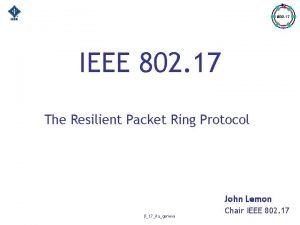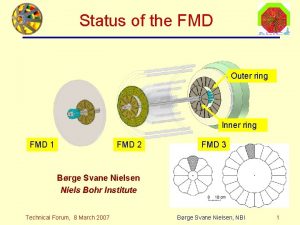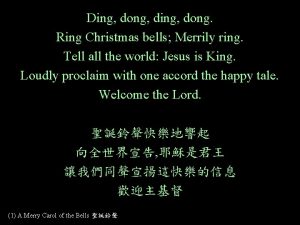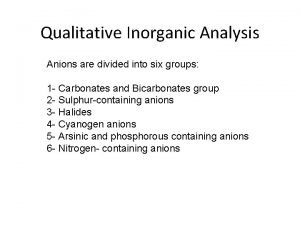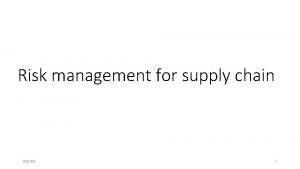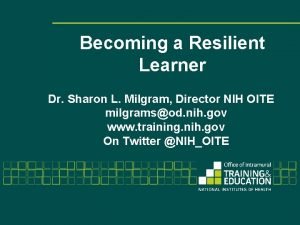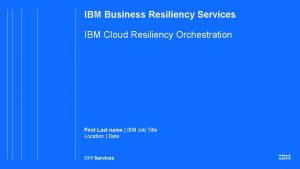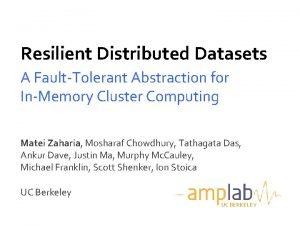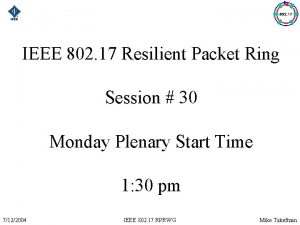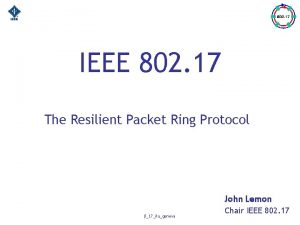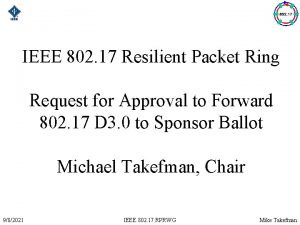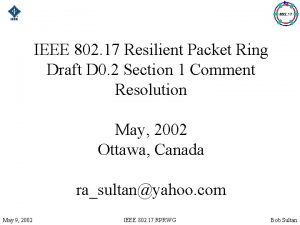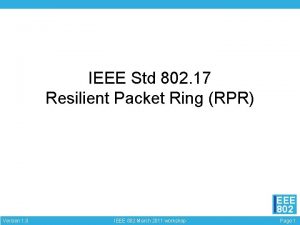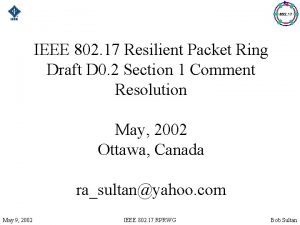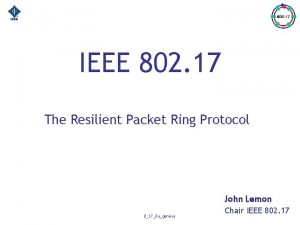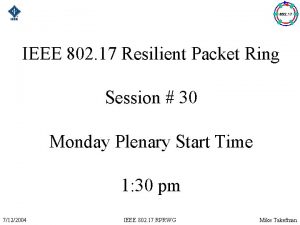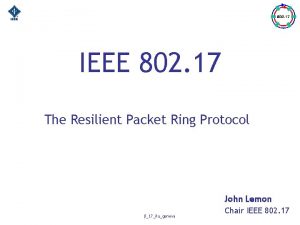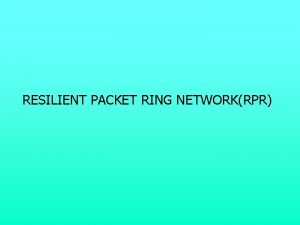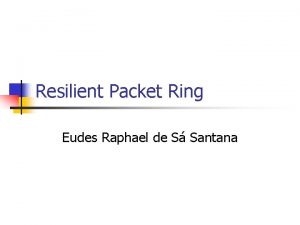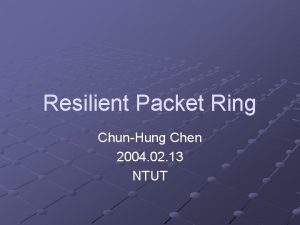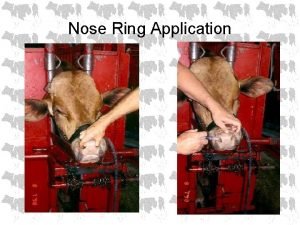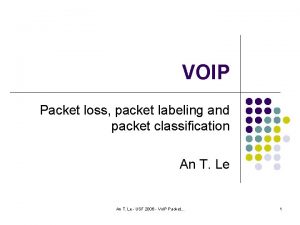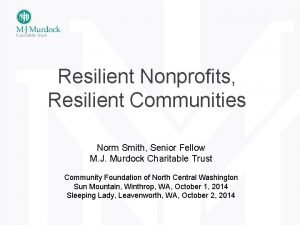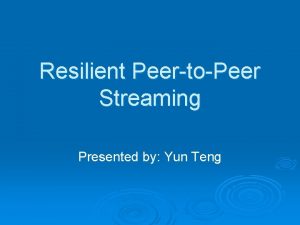Resilient packet ring Resilient packet ring IEEE 802
















![Resilient packet ring • Local_fair_rate – Local_fair_rate[n] of congested node n denotes fair rate Resilient packet ring • Local_fair_rate – Local_fair_rate[n] of congested node n denotes fair rate](https://slidetodoc.com/presentation_image_h2/69896f16e233968dcb66cca7fb4d512f/image-17.jpg)








- Slides: 25

Resilient packet ring

Resilient packet ring • IEEE 802. 17 resilient packet ring (RPR) – RPR targets metro edge & metro core areas – RPR aims at combining • SONET/SDH’s carrier-class functionalities of high availability, reliability, and profitable TDM service (voice) support • Ethernet’s high bandwidth utilization, low equipment cost, and simplicity – RPR vs. SONET/SDH & Ethernet • Similar to SONET/SDH rings, RPR provides fast recovery from single link or node failure within 50 ms & carries legacy TDM traffic with high-level Qo. S • Similar to Ethernet, RPR exhibits improved bandwidth utilization due to statistical multiplexing • Unlike SONET/SDH rings, RPR utilizes full ring bandwidth under normal (failure-free) operation • Unlike Ethernet, RPR provides fairness

Resilient packet ring • Architecture – Bidirectional packetswitched ring with counterrotating fiber ringlets 0 and 1 – Up to 255 ring nodes – RPR MAC over several physical layers (e. g. , Ethernet, SONET/SDH) – Shortest path routing unless preferred ringlet specified by MAC client – Destination stripping enables spatial reuse => increased capacity

Resilient packet ring • Packet forwarding – Intermediate nodes forward packet if they don’t recognize destination MAC address in packet header – Forwarding methods • Cut-through – Packet forwarded before completely received • Store-and-forward – Packet forwarded after completely received – Supplementary 1 -byte time-to-live (TTL) field • Added to each packet by RPR MAC control entity • Value decremented by each intermediate node • Prevents packets with unrecognized destination MAC address from circulating forever

Resilient packet ring • Multicasting – Multicast group membership identified by group MAC destination address – Realized by means of broadcasting => no spatial reuse – Unidirectional flooding • Packet removal based on expired TTL or matching source MAC address – Bidirectional flooding • Packets removal at cleave point based on expired TTL • Cleave point can be put on any span

Resilient packet ring • Topology discovery – RPR’s topology discovery protocol determines connectivity, order of nodes, and status of each link – At system initialization • All nodes broadcast topology discovery control packets on both ringlets with TTL value equal to 255 (maximum number of nodes) • Each topology control packet contains information about status of corresponding node & its attached links • By receiving all topology control packets, each node is able to compute complete topology image (number & ordering of nodes, status of each link) • Topology image is stored in topology database of each node

Resilient packet ring • Topology discovery – During normal operation • Topology discovery packet is sent immediately by a – New node inserted into ring – Node after detecting link/node failure – Node after receiving topology discovery packet inconsistent with its current topology image • Ripple effect – First node noticing a topology change sends topology discovery packet, followed by all other nodes • Consistency check – Once topology image is stable for specified time period, each node performs consistency check • Robustness – After achieving stable & consistent topology image, each node continues to periodically send topology discovery packets

Resilient packet ring • Topology discovery – Use of topology database • Determining number of hops between source & destination nodes • Setting TTL field to appropriate value • Selecting shortest path to any destination node

Resilient packet ring • Node architecture

Resilient packet ring • Node architecture – Salient features • Virtual output queueing (VOQ) to avoid head-of-line (HOL) blocking • Ingress traffic throttled by means of token bucket traffic shapers • Lossless transit path – Single-queue mode » Single FIFO queue called primary transit queue (PTQ) to store class A in-transit traffic – Dual-queue mode » Additional FIFO queue called secondary transit queue (STQ) to store class B & C in-transit traffic – RPR network may consist of both single-queue & dual -queue nodes • Checker, scheduler, and traffic monitor

Resilient packet ring • Traffic classes – Class-based priority scheme to achieve Qo. S support & service differentiation – Traffic classes & subclasses • Class A: Low-latency & low-jitter service with guaranteed bandwidth • Class B: Predictable latency & jitter service • Class C: Best-effort Traffic class Subclass Bandwidth preallocation A A 0 A 1 Reserved Reclaimable B B-CIR B-EIR Reclaimable No preallocation C - No preallocation

Resilient packet ring • Bandwidth preallocation – To fulfill service guarantees, bandwidth preallocated for traffic subclasses A 0, A 1, and B-CIR • Subclass A 0 – Reserved bandwidth – Reservation done by using topology discovery protocol – Reserved bandwidth dedicated to node making reservation • Subclasses A 1 & B-CIR – Part of unreserved bandwidth preallocated to subclasses A 1 & B-CIR => reclaimable bandwidth – Reclaimable bandwidth not used by A 1 & B-CIR (as well as remaining unreserved bandwidth) can be used by subclasses B-EIR & C • Subclasses B-EIR & C – No bandwidth preallocation – Fairness eligible traffic

Resilient packet ring • Access control – Single-queue mode • Highest priority given to local control traffic if PTQ not full • Without local control traffic, in-transit traffic is given priority over local ingress traffic – Dual-queue mode • Highest priority given to local control traffic if both PTQ & STQ not full • Without local control traffic, PTQ always served first • If PTQ empty, local ingress traffic served until STQ reaches certain threshold • If STQ threshold crossed, STQ in-transit traffic is given priority over local ingress traffic – Benefits • Lossless transit path for all traffic classes • Class A traffic experiences only propagation delay & occasional queueing delay due to nonpreemptive scheduling

Resilient packet ring • Fairness control – Lossless path property gives rise to starvation of downstream nodes => fairness problem – Distributed fairness control protocol • Dynamically throttling upstream traffic • Maximizing spatial reuse

Resilient packet ring • RIAS reference model – Fairness control designed according to ring ingress aggregated with spatial reuse (RIAS) reference model – RIAS reference model • Fairness on each link is determined at granularity of ingress aggregated (IA) flow (only traffic subclasses B-EIR & C) • IA flow: aggregate of all flows originating from a given ingress node • Goals – Throttle IA flows at ring ingress nodes to their network-wide fair rates => alleviated congestion – Let unused bandwidth be reclaimed by IA flows => maximized spatial reuse • Fairness control realized by backlogged nodes sending fairness control packets based on local measurements to upstream ring nodes

Resilient packet ring • Fairness control algorithm – Framework • Each node measures forward_rate & add_rate as byte counts at output of scheduler – Forward_rate: serviced rate of all in-transit traffic – Add_rate: serviced rate of all local traffic • Both traffic measurements are – taken over prespecified time period called aging_interval – low-pass filtered by means of exponential averaging using parameter 1/LPCOEFF for current measurement & 1 - 1/LPCOEFF for previous average • Measurements are used by nodes to detect local congestion • When node n is congested, it calculates its local_fair_rate[n] • Congested node n sends fairness control packet containing local_fair_rate[n] to upstream nodes • Upstream nodes sending via n throttle their traffic to fair rate • When congestion clears, all nodes periodically increase rate
![Resilient packet ring Localfairrate Localfairraten of congested node n denotes fair rate Resilient packet ring • Local_fair_rate – Local_fair_rate[n] of congested node n denotes fair rate](https://slidetodoc.com/presentation_image_h2/69896f16e233968dcb66cca7fb4d512f/image-17.jpg)
Resilient packet ring • Local_fair_rate – Local_fair_rate[n] of congested node n denotes fair rate at which source nodes are supposed to transmit via intermediate node n – Congested node n sends fairness control packet containing local_fair_rate[n] to upstream node n-1 – If node n-1 is also congested, it forwards fairness control packet to upstream node n-2 containing min {local_fair_rate[n], local_fair_rate[n-1]} – If node n-1 is not congested but its forward_rate > local_fair_rate[n], it forwards fairness control packet to upstream node n-2 containing local_fair_rate[n] – Otherwise, node n-1 sends null-value fairness control packet to indicate lack of congestion

Resilient packet ring • Allowed_rate_congested – When upstream node i receives fairness control packet with local_fair_rate[n], it decreases rate controller value of all flows traversing congested node n to allowed_rate_congested – Allowed_rate_congested equals sum of serviced rates of all flows (i, j) originating from node i & traversing node n on their path toward destination node j => local traffic rates of upstream node i does not exceed local_fair_rate[n] – Otherwise, if upstream node i receives null-value fairness control packet, it increases allowed_rate_congested by prespecified value to reclaim bandwidth

Resilient packet ring • Operation modes – Fairness control algorithm operates in either of two operation modes • Aggressive mode (AM) • Conservative mode (CM) – Both AM & CM operate within the same aforementioned framework – AM & CM differ in how node detects congestion & calculates its local fair rate

Resilient packet ring • Aggressive mode (AM) – AM is default operation mode of RPR deploying dualqueue mode – Operation • Node n is considered congested whenever STQ_depth[n] > low_threshold or forward_rate[n] + add_rate[n] > unreserved_rate • A congested node n calculates its local_fair_rate[n] as the serviced rate of local traffic add_rate

Resilient packet ring • Conservative mode (CM) – CM deploys single-queue mode by default – Each node uses access timer – Operation • Node n is considered congested whenever access timer expires or forward_rate[n] + add_rate[n] > low_threshold • If node n is congested only in current aging_interval: local_fair_rate[n] = unreserved_rate/# of active nodes • If node n is continuously congested: – local_fair_rate[n] ramps up if forward_rate[n] + add_rate[n] < low_threshold – local_fair_rate[n] ramps down if forward_rate[n] + add_rate[n] > high_threshold

Resilient packet ring • Protection – Due to bidirectional dual-fiber ring topology, RPR is able to recover from single link or node failure – Fault detection • Alarm signal issued by underlying physical layer technology (e. g. , loss-of-signal (LOS) alert in SONET/SDH) • No keep-alive messages from neighboring node for prespecified period of time – Fault notification • Upon fault detection, node broadcasts topology discovery update packet to inform all ring nodes about failure – Fault recovery • RPR deploys two protection techniques – Wrapping (optional) – Steering (mandatory)

Resilient packet ring • Wrapping – Optional in RPR – If deployed, all nodes must support it – Similar to automatic protection switching (APS) of SONET/SDH self-healing rings (SHRs) – Affects only packets marked wrap eligible (we bit in header is set) – Benefits • Fast recovery time • Minimized packet loss – Drawback • Bandwidth inefficiency

Resilient packet ring • Steering – Mandatory in RPR – After receiving a topology discovery update packet sent by wrapping node, a source node sends local ingress traffic on the ringlet in failure-free direction – Benefit • Higher bandwidth efficiency than wrapping – Wrap-then-steer protection strategy • recommended if both wrapping & steering used together => packet reordering

Resilient packet ring • In-order delivery – RPR deploys two packet modes • Strict packet mode (default) – Packets guaranteed to arrive in same order as sent – Strict order (so) bit in header is set to identify strict order packets – Strict order packets cannot be marked wrap eligible => discarded at wrap point – After learning about failure, nodes stop sending strict order packets & discard strict order in-transit packets until topology stabilization timer expires – With stable & consistent updated topology image, nodes start to steer strict order packets onto respective ringlet • Relaxed packet mode (optional) – Relaxed packets may be steered immediately after learning about failure & are not discarded from transit queues
 Resilient packet ring
Resilient packet ring Bridges from 802.x to 802.y
Bridges from 802.x to 802.y Bridges from 802.x to 802.y
Bridges from 802.x to 802.y Ieee802.22
Ieee802.22 Arquitetura ieee 802
Arquitetura ieee 802 Norma ieee 802
Norma ieee 802 Ieee 802 standard
Ieee 802 standard 802 15
802 15 802 ieee
802 ieee Ieee 802
Ieee 802 Ieee 802 family
Ieee 802 family Ieee 802 3 compliance
Ieee 802 3 compliance Constriction ring and retraction ring
Constriction ring and retraction ring Inner ring and outer ring
Inner ring and outer ring Deep inguinal ring
Deep inguinal ring Oblique passage
Oblique passage Ring christmas bells ding dong
Ring christmas bells ding dong What is the brown ring in the brown ring test
What is the brown ring in the brown ring test Ring christmas bells ring them loud
Ring christmas bells ring them loud Resilient temperament meaning
Resilient temperament meaning How can more resilient
How can more resilient Prepared and resilient learner
Prepared and resilient learner Ibm resiliency orchestration
Ibm resiliency orchestration How can be more resilient
How can be more resilient Resilient attitude
Resilient attitude Resilient distributed datasets
Resilient distributed datasets
